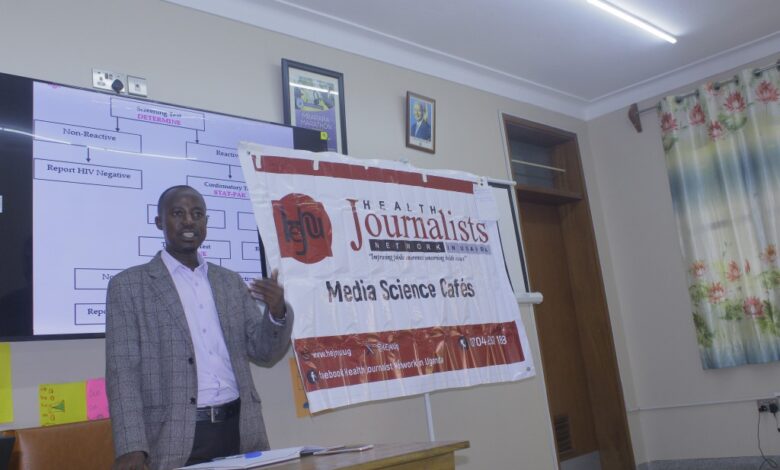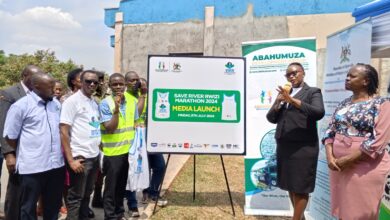Health Journalists Network launches a campaign to end HIV transmission among infants by 2030
By Joshua Nahamya

The Health Journalists Network Uganda (HEJNU) has embarked on a breastfeeding campaign to reduce mother-to-child HIV transmission among children.
During the Health Journalists Network Uganda (HEJNU) media café to equip journalists on how best to report health stories at holy innocents’ children’s hospital, Fredrick Kamugisha-Health educator Mbarara district, said that the journey of eliminating mother to child transmission (EMCT) begins with the mothers going for antenatal care.
“The mother must understand the importance of breastfeeding and you cannot start talking about breastfeeding after delivery” Kamugisha said
He said that it is during antenatal care that the mother is taken through the importance of breastfeeding and challenges likely to be faced thus appealing to pregnant women to always go for early antenatal care to protect their babies from HIV transmission.
“When a pregnant mother is examined and found positive, she is initiated immediately to reduce the viral load of that mother to stop the mother-child transmission” Kamugisha said
He added that “At 6 weeks we do what we call early infant diagnosis (PCR test) to ascertain whether a child is positive or negative.
Kamugisha said that the World health organization (WHO) recommendation of HIV mothers avoiding breastfeeding the babies to prevent them from acquiring the virus has been challenged by socioeconomic status in Africa which poses a risk to the newborns.
“This is practical if there are affordable and feasible alternatives that can feed that child but basing on our setting like Africa, Uganda in particular it may not be possible” adding that, if they are not available then we recommend breastfeeding” he said
Kamugisha added that if the mother is not taking the drugs properly, the viral load will be high and the virus will exist in the milk thus encouraging institutional deliveries where medics educate the mothers on EMCT.
“They need to understand that taking drugs consistently reduces risks of children from acquiring HIV/AIDS.” He said
According to the Ministry of health (MOH) report , before introduction of EMCT, the mother to child transmission used to be between 25-40 percent but with the ushering in of the programme, the HIV rate in breastfeeding mothers went as low as below 5 percent and with non-breastfeeding mothers as low as below 2 percent.
The HIV prevalence rate in Mbarara district is 4.1 percent and the incidence rate is at 3 per a 000, meaning that out of 1000 people in the district, three can acquire HIV, with a total of 7000 people HIV positive.
According to Dr. Mike Kyewalyanga, pediatrician at Holy Innocents Children’s hospital, 5 percent of HIV can be transmitted through breastfeeding thus appealing to positive mothers to breastfeed for just a year.
“After one year, the benefits of breast milk have reduced so we rather stop the breastfeeding and minimise the risk of transmission than keeping the baby on the breast with minimal benefits” Kyewalyanga emphasized
He said that mother to child transmission currently stands at 466 per 000s of HIV cases meaning that 466 children are at a risk of HIV transmission out 100,000 live buts (mothers with HIV)
“The target as per world health organization and UNICEF should be 50 mothers out of 100,000 to take us to the vision 95-95-95 to eliminate HIV/AIDS by 2030” he said
Dr. Kyewalyanga partially attributes the high HIV prevalence rate to the 2020 covid19 lockdown that denied patients access to proper medication to suppress the virus.
“In the healthcare giving system there was an increase in HIV spread because people would not come to the facilities to test the antiretroviral therapy (ART) as before. And then also confining people in a redundant area worsened the sexual behavior,” he said
Kyewalyanga challenged the adolescents to avoid unprotected sex. “Your sexual behavior should be upright, don’t find partners and you believe that you tested them and they are HIV negative thinking they are the right sexual partner for you, and you will fall into a trap. I advise that if you cannot abstain then use a condom.” He explained
Catherine Ankunda, a mother and an HIV victim in Mbarara, appreciated the government’s efforts to curb mother to child HIV/AIDS transmission.
“If you go to the hospital they test and sensitize you on how you should live. It is up to you as a parent to practise whatever they tell you to protect your child from HIV transmission or not” Ankunda said
She said that being HIV positive is not the end of life, thus encouraging people infected with the virus to routinely take their medication to suppress the viral load.
“People should know their status and they should know that living with HIV is not a crime. It is not the end of life because you can live like any other person if you follow the given counselling and medication” Ankunda said
She also encouraged other people who are sick to open up to their partners. “ I know it is hard but I opened up and I got a man who is negative we produced a healthy baby, we are living happily a discordancy life and my husband is very supportive so I advise HIV positive mothers to follow the medics’ prescription so that we can always produce healthy children” Ankunda explained
However she challenged researchers to get advanced HIV treatment for babies in the form of an injection rather than tablets that are complicated to administer the babies at birth preventing them from HIV transmission.
“The biggest challenge is administering the drug to the child, if it was an injection at least there it would be easy for the children but sometimes you give her, she vomits and you find she has not swallowed the prescribed dose it is a challenge that I have so far encountered protecting my child from transmission” Ankunda emphasized
AIDS is a leading cause of death among young people aged 10-24 in Africa and the second leading cause globally according to the World Health Organization [WHO]. It is estimated that the number of 10-24-year-old Africans is set to rise more than 750 million by 2060 if HIV/AIDS prevention mechanisms are not taken seriously.
In Uganda, the HIV prevalence rate stands at 5.4 percent with females contributing a greater percentage compared to males at 3.9 percent. The highly affected districts include; Kalangala, Fort Portal, Mbarara, Bushenyi among others.
The major drivers of HIV prevalence include; transactional sex practiced by commercial sex workers, alcohol influence, cultural practices, poverty, myths, unsterilized equipment among other existing modes of transmission.




